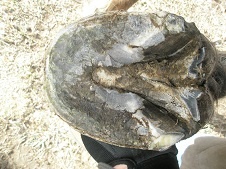I got started on barefoot trimming out of necessity. Kim’s horse Curl had foundered and CSU said she would never be sound enough to ride again. With a lot of help from my farrier, I started following Pete Ramey’s protocol for foundered horses. That was in March of that year, Kim was riding her horse again by July. In addition to being rideable, Curl was gaiting better than she ever had.
Barefoot trimming was a piece I had been missing to the puzzle of helping horses gait better. Now along with saddle fit/bit issues, suppling exercises, and rider balance, I find a proper barefoot trim is a big part of helping horses.
Key Points to a Proper Barefoot Trim
The sole is your guide
- Exfoliate old dead flaky sole but do not cut into fresh growing sole.
- Don’t cut the hoof wall to a length or angle based on a measurement on the exterior of the hoof which requires you to cut into the sole.
- Cut the hoof wall to extend just past the growing sole. You should be able to catch your fingernail on the hoof wall but it should extend no more than one-eighth inch.


The “Mustang Roll”
- The Mustang Roll eases break over, and reduces the tendency of a hoof wall to chip.
- The Mustang Roll replaces forces that pull the hoof apart with forces that push the hoof together.
- The Mustang Roll is created by shortening the toe with a vertical cut as apposed to a horizontal cut that thins the sole.

The bottom of the foot is arched
- Unlike preparing a hoof for a shoe, the bottom of the hoof is not flattened.
- A front to back arch results from following the sole when trimming the hoof wall.
- This arch contributes to expansion and contraction of the hoof improving circulation and hoof health

Trim in frequent intervals
- If we wait until we see something that needs correcting, the horse’s growth mechanism will have already adjusted hoof growth to try to fix the issue. This results in thin walls and slow growth.
- If we trim too much to fix a problem, the horse registers it as a wound and will grow it back and then some over a normal eight week trimming interval.
- If we trim frequently, we create ideal wear and the horse grows the ideal hoof.
- I recommend trimming on a four to six week interval for normal maintenance, and a two to three week interval to correct serious problems


A proper barefoot trim almost always results in an easier breakover and a heal first landing. This creates a much softer sounding footfall. I think of it as if the horse put on slippers. I encourage you to make an appointment for me to help your horse.
Mountain Magic Ranch stresses: Safety, Balance, Communication and Unity
